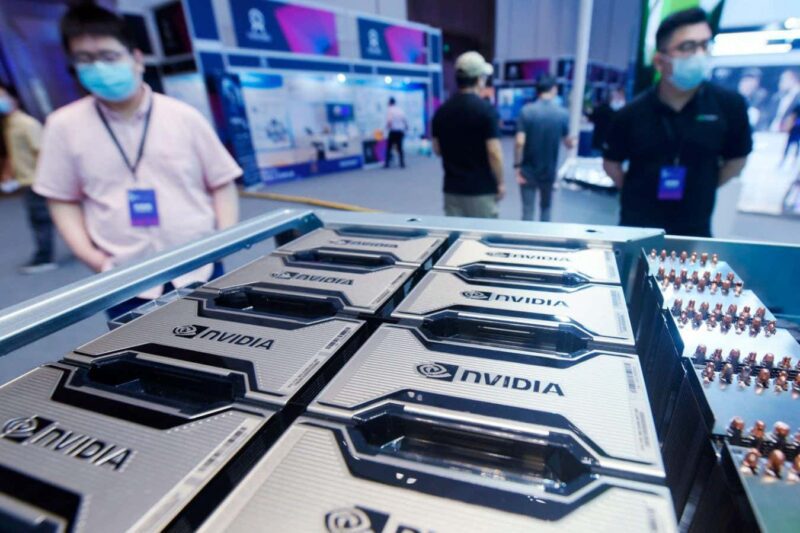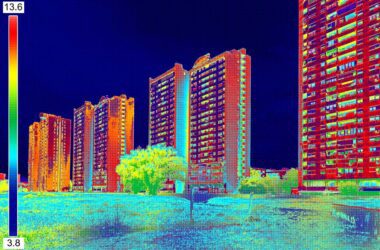Most AIs are run on servers made by Nvidia, which are packed with power-hungry GPU chipsAssociated Press / Alamy
Some researchers suggest that the energy consumed by computers to train and run large AI models is a crucial worry that is being disregarded within the many debates about the possible risks of artificial intelligence.
According to Alex de Vries of the VU Amsterdam School of Business and Economics, AI is going to be a major source of global carbon emissions in the near future. If Google shifted its whole search operation to AI, he says, the corporation would consume 29.3 terawatt hours of electricity annually. That’s more than the entire annual electrical output of Ireland and nearly double Google’s projected 2020 total of 15.4 terawatt hours. When asked for comment, Google remained silent.
There is, on the one hand, reason to keep calm. More than 4 million of the sophisticated computer processors called graphics processing units (GPUs) are needed to make such a move, and there is a severe shortage of these devices right now.A hundred billion dollars is a lot of money, even for Google.
However, in the long run, AI’s energy consumption will be a real issue. This year, Nvidia will ship 100,000 of its A100 servers, which may consume 5.7 terawatt hours of electricity annually. Nvidia sells 95% of the GPUs used for AI.
New factories coming online and significantly increasing production capacity might make things considerably worse in the long run. According to de Vries, the energy requirements for the 1.5 million servers produced annually by 2027 by chip supplier TSMC for Nvidia might total 85.4 terawatt hours per year.
Companies’ haste to incorporate AI into a wide variety of products bodes well for Nvidia’s ability to move inventory. However, de Vries stresses the importance of limiting AI’s use due to its enormous ecological cost.
As he puts it, “people have this new tool and they’re like, ‘OK, that’s great, we’re gonna use it,'” regardless of whether or not they truly use it.
They don’t stop to consider whether or not this will improve the lives of the people who will actually be using it. And that disconnection is the root of the issue, in my opinion.
Consumers, according to Sandra Wachter of Oxford University, should be informed that there is a cost associated with tinkering with these models. According to Wachter, “it’s one of the topics that really keeps me up at night.” We use technology without considering the amount of energy, water, or room it necessitates. She argues that firms would be pushed to act more ethically if laws were passed requiring disclosure of the models’ environmental impact.
“We recognise training large models can be energy-intensive and is one of the reasons we are constantly working to improve efficiencies,” an OpenAI representative said to New Scientist about the company’s efforts to reduce ChatGPT’s carbon footprint. We spend a lot of thought to how we may most effectively utilise our computing resources.
According to Hugging Face’s co-founder and AI expert Thomas Wolf, “smaller AI models are now approaching the capabilities of larger ones,” which might lead to huge energy savings. He claims that Mistral 7B and Meta’s Llama 2 are just as capable as GPT4, the AI powering ChatGPT, but being anywhere from ten to one hundred times smaller. “You don’t need a Ferrari to get to work, and neither do you need GPT4 for everything.”
According to a representative from Nvidia, the company’s GPUs consume less power when operating AI than conventional central processing units (CPUs). Accelerated computing using Nvidia technology is the most efficient processing architecture for AI and other data centre tasks, they believe. Each new generation of our products improves upon the previous one in both performance and efficiency.
FAQs
- Why is AI’s energy consumption a concern?
- The energy required to train and run large AI models is significant, potentially leading to substantial global carbon emissions.
- How does Google’s potential AI shift compare in terms of energy consumption?
- If Google shifted its entire search operation to AI, it could consume 29.3 terawatt hours annually, more than Ireland’s entire annual electrical output.
- What role do GPUs play in AI’s energy consumption?
- GPUs, especially those from Nvidia, are the primary processors used for AI. Their production and operation contribute significantly to the energy consumption associated with AI.
- Are there any solutions to reduce AI’s carbon footprint?
- Some experts believe that smaller AI models, which are becoming increasingly efficient, can achieve similar capabilities as larger ones but with a fraction of the energy consumption.
- What is the stance of companies like Nvidia and OpenAI on this issue?
- Nvidia claims their GPUs are more energy-efficient for AI than traditional CPUs. OpenAI acknowledges the energy-intensive nature of training large models and is working on improving efficiencies.







